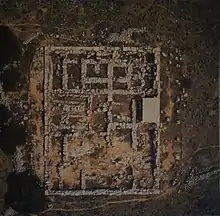Chryssolakkos
Chryssolakkos means the "Pit of gold". This is where the ancient necropolis (royal burial enclosure or cemetery, 1700BCE) in Malia, an ancient Minoan town in Crete, Greece is located.

The Malia Pendant, on display at the Heraklion Archaeological Museum as of 2020, was found here and is of high quality gold-smithery of the Minoan times. The jewel takes the form of two insects, which are identical (mirror images) joined head-to-head with the tips of their abdomens almost touching in a symmetrical or heraldic arrangement. The insects’ wings spread backwards. From the lower edges of the wings and a point close to the tip of the abdomen dangle three discs. With their legs, the insects are "grasping" a centrally placed circular disc and there is a second, smaller, smooth globule placed above this and between the insects' heads as if they were eating it. Megascolia maculata, a wasp, was proposed as the model for the insects, and the fruits of a native Cretan herb Tordylium apulum as a model for the three discs that are suspended from the pendant.[1]
References
- Nelson, E. C., Mavrofridis, G., & Anagnostopoulos, I. T. (2020). NATURAL HISTORY OF A BRONZE AGE JEWEL FOUND IN CRETE: THE MALIA PENDANT. The Antiquaries Journal, 1–12. http://doi.org/10.1017/S0003581520000475